The best food in Amman is found at the secret, local places where the migrant population goes for the flavors and scents they miss most.
Amman is humble and dense, a dusty makeshift capital developed by necessity, not design, for the waves of migrants and refugees who’ve fled to Jordan through the centuries. Its eastern side is packed with lower-income Jordanians and refugees surviving in tiny sand-colored rooms stacked on top of each other; its western side hosts flocks of humanitarian workers who’ve come for those refugees, living alongside diplomats, foreigners and other elites. The two sides intersect in the balad, Jordan’s ancient downtown center and the heartbeat of Amman, with staircases running like arteries up to different neighborhoods, most of them centered on hills–thus the names Jabal (mountain) Amman, Jabal al-Weibdeh, Jabal al-Akhdar, Jabal Hussein, and so on.
The best food in Amman isn’t what tourists are typically recommended but the secret, local places where the migrant population goes for the flavors and scents they miss the most. Here’s our guide to eating your way through them.
Shipse Pasta at Circassian Women’s Association on 7th circle
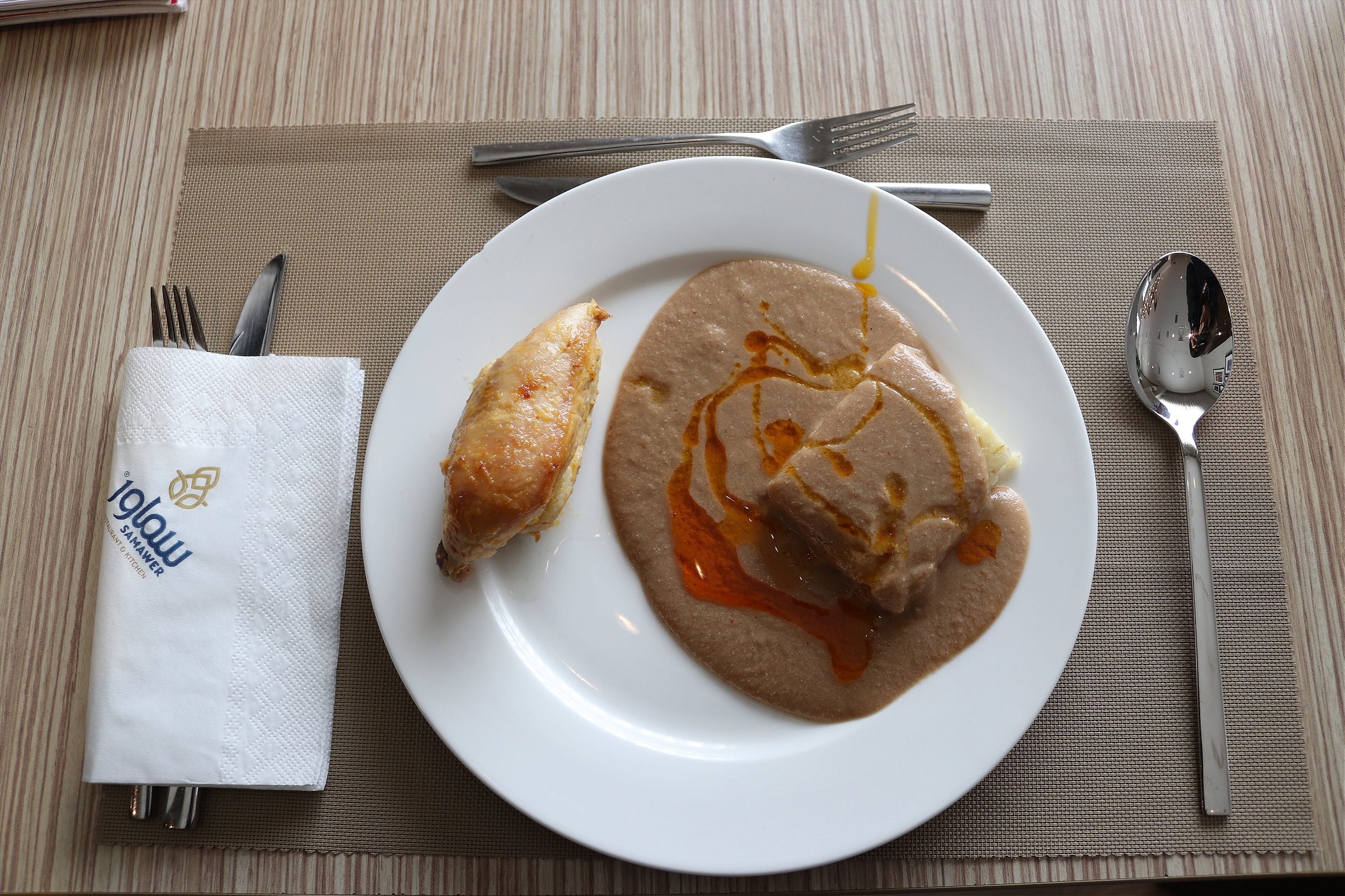
We technically begin on Shabsough Street, the first street in Amman, named after a tribe of Circassians, Russian Muslims fleeing persecution who settled the city in the 1870s, long before Jordan existed as a country. Shabsough is in the balad, near the Roman Amphitheater where the tribes first sought shelter. Amman was just a cluster of Roman ruins then, surrounded by grazing land for Bedouin tribes that now had to share with the Circassians. Feuds broke out in some cases, especially when the Circassians sided with the Ottoman empire during the Arab Revolt of 1916-18—but when Britain took over, establishing the Emirate of Transjordan and declaring Amman its capital, the Circassians quickly swore allegiance to Emir Abdullah I. Jordan’s Circassians have been loyal to the royal family since Hashemite rule began in the 1920s and through its transition into today’s Hashemite Kingdom. About 100,000 of the world’s 3.7 million Circassians live in Jordan, and the king still has a ceremonial royal guard comprised of Circassian uniformed men within his palace.
These days, most Jordanians have no idea what the most famous Circassian dish is, and few have made it to the one place where you can taste it in Amman: the Circassian Women’s Association’s daily buffet, which costs a hefty 20 JD and is located near 7th circle, on the outskirts of an upscale part of town. Shipse pasta is what Circassians ate back in the Caucasus, according to Jan Janakat, manager of the women’s association. It’s a thick, spicy and salty gravy of walnut, garlic, and paprika, simmered with chicken and poured over a mix of bulgur and rice, with a drizzle of red hot pepper oil on top. It’s heavy and warms you from the inside, like most of the food Circassians ate in the cold winters of Russia.
Lahme bi ajine/lahmacun at Jawharat Armenia in Al-Ashrafiyeh
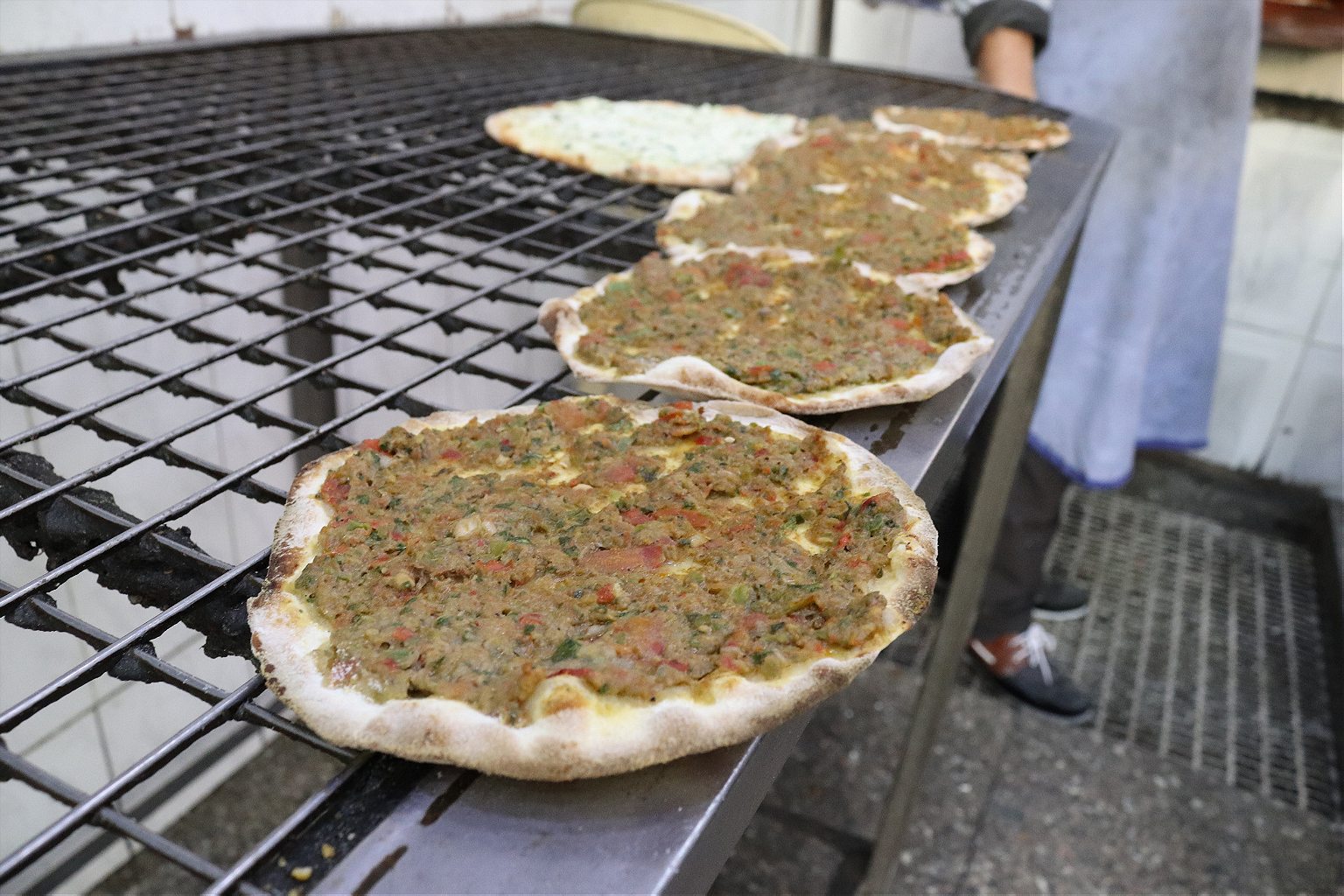
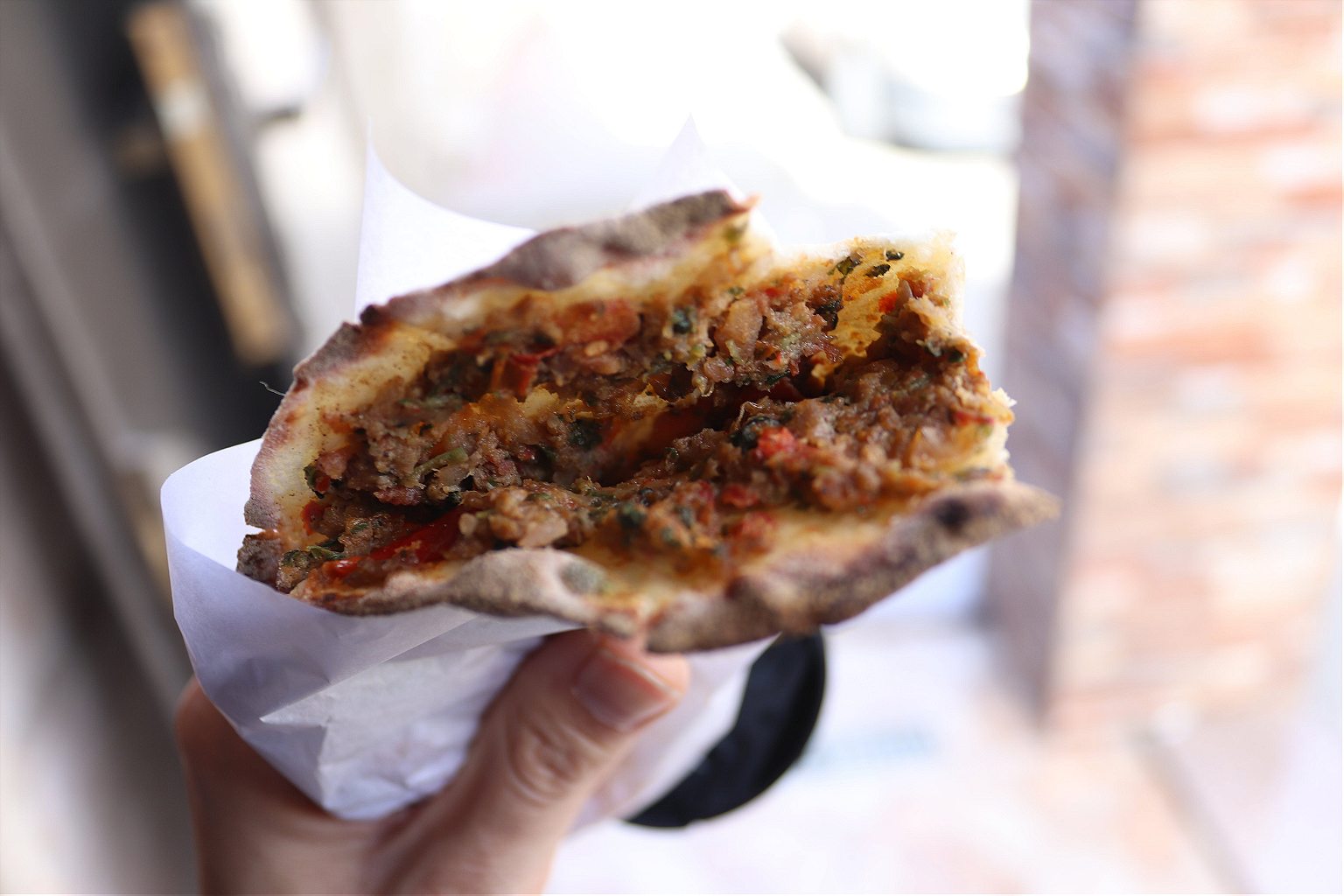
The best view of Amman is on its highest hill, Jabal al-Ashrafiyeh. There, you’ll find Abu Darwish mosque, an iconic black-and-white checkered building built by the Circassians in the 1960s, as well as a large Armenian church, built by Armenian Christian refugees who came to Jordan on foot, fleeing Ottoman massacres during World War I. Several thousand settled in Amman, congregating in al-Ashrafiyeh, which is also known as the Armenian quarter. Take a servees or a taxi—do not walk—to the Armenian church in Ashrafiyeh, walk down the road a bit and you’ll find an old bakery called Jawharat Armenia (“jewel of Armenia”), where they serve just one thing: lahmacun, an Armenian flatbread ubiquitous in the Middle East, sometimes called “Armenian pizza.” The small store is centered around an open, flaming wood-brick oven. You can watch as bakers roll out soft, white dough, paint it with a mix of minced lamb, tomatoes, onion and peppers, then slot it into the oven on large wooden paddles. The lahmacun, or lahme bi ajine, as it’s known in Arabic, sits in pat rows. Within seconds, the dough is bubbling and rising, and in minutes, it’s out of the oven, folded into crisp thirds and ready for you. It’s smoky and hot, an explosion of spiced lamb and crusty bread, accented with bright tomatoes and sweet roasted onions. Customers take the flatbreads to go, but some devour the whole thing before they’ve gotten out of the shop.
Mansaf at Al Quds in Balad
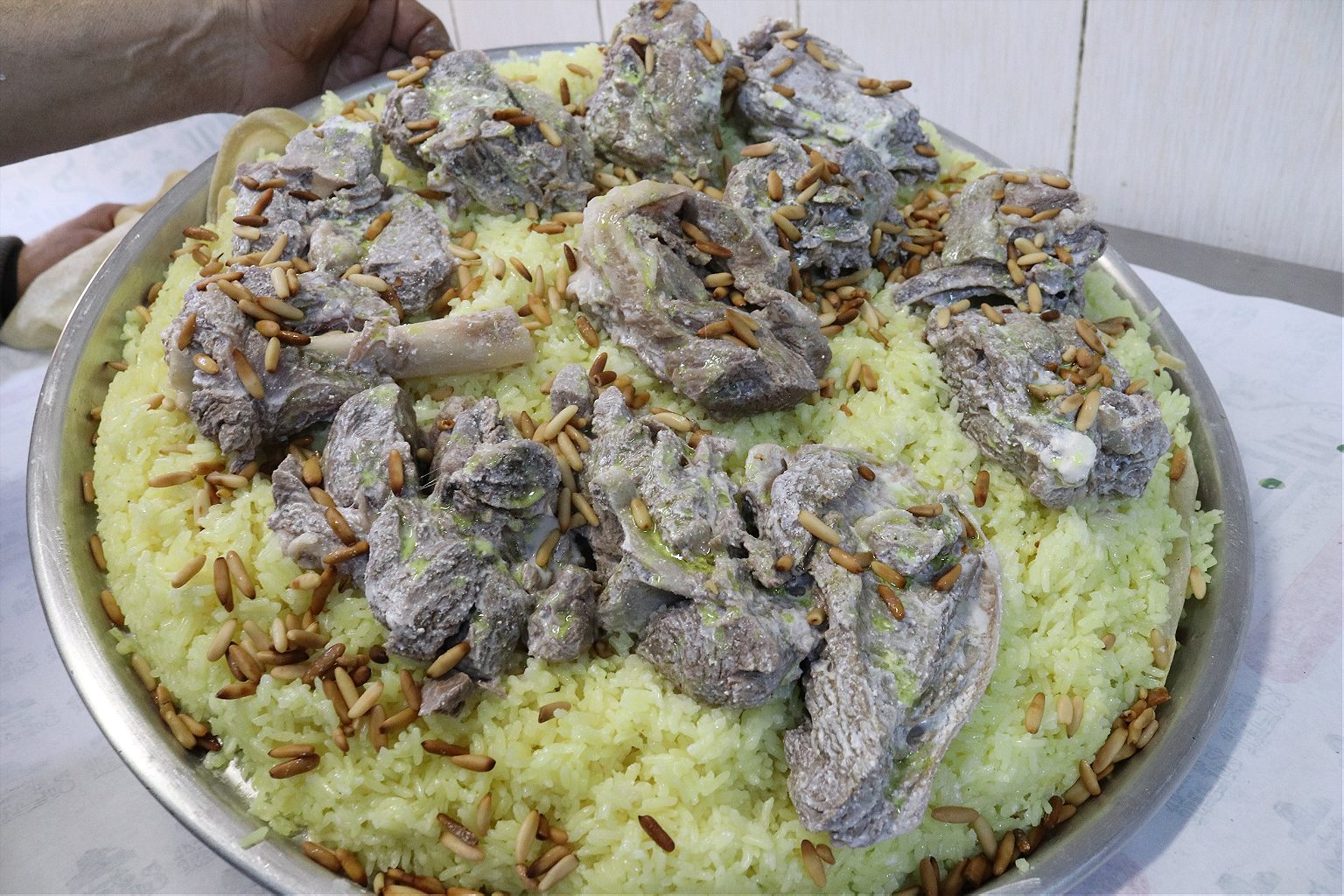
The quintessential Jordanian dish, pride of the Bedouins and top recommendation you’ll get from every Jordanian you meet, is mansaf: a mountain of tender, fall-off-the-bone lamb piled on saffron rice sautéed in butter and a thin layer of chewy shrak bread, then covered with a warm, tangy yogurt sauce called jameed, and finished off with a crunchy garnish of fried almonds and pine nuts. It’s the kind of dish that leaves you incapacitated for the rest of the day, and is best eaten in a Jordanian home, standing around a table with your left hand behind your back, using only your right hand to scoop bite-size balls of lamb, rice and jameed into your mouth. The Bedouin tribes of Karak, two hours south of Amman, are renowned for making the best jameed, which comes dried in oblong, rock-hard blobs that have to be soaked and rehydrated before cooking.
If you don’t manage to score an invite to anyone’s home for mansaf, the next-best version in Amman is at al-Quds restaurant in the balad, where 70-year-old Abu Ashraf has been making mansaf for more than twenty years. Here, the mansaf comes economy-size, in single serving with jameed on the side. It’s on a menu along with all the Jordanian-Palestinian classics, from molokheya, a garlicky green soup of Jew’s mallow with lamb and fresh lemon, to musakhan, a flatbread topped with onions and sumac, pillowing a roasted chicken that’s at once sweet, tart, and salty. The restaurant’s owners are Palestinian, not originally Jordanian. That seeming mishmash of people and ingredients from outside of Jordan actually reflects its history, though: today’s Palestinian West Bank was part of Jordan between the 1948 and 1967 wars, when Jordan gave citizenship to the Palestinian residents there, and Jordan itself was part of Greater Syria in the Ottoman days, along with today’s Israel-Palestine, Syria and Lebanon, all of which shared similar ingredients and ways of cooking.
Knafeh at Habibeh in Balad
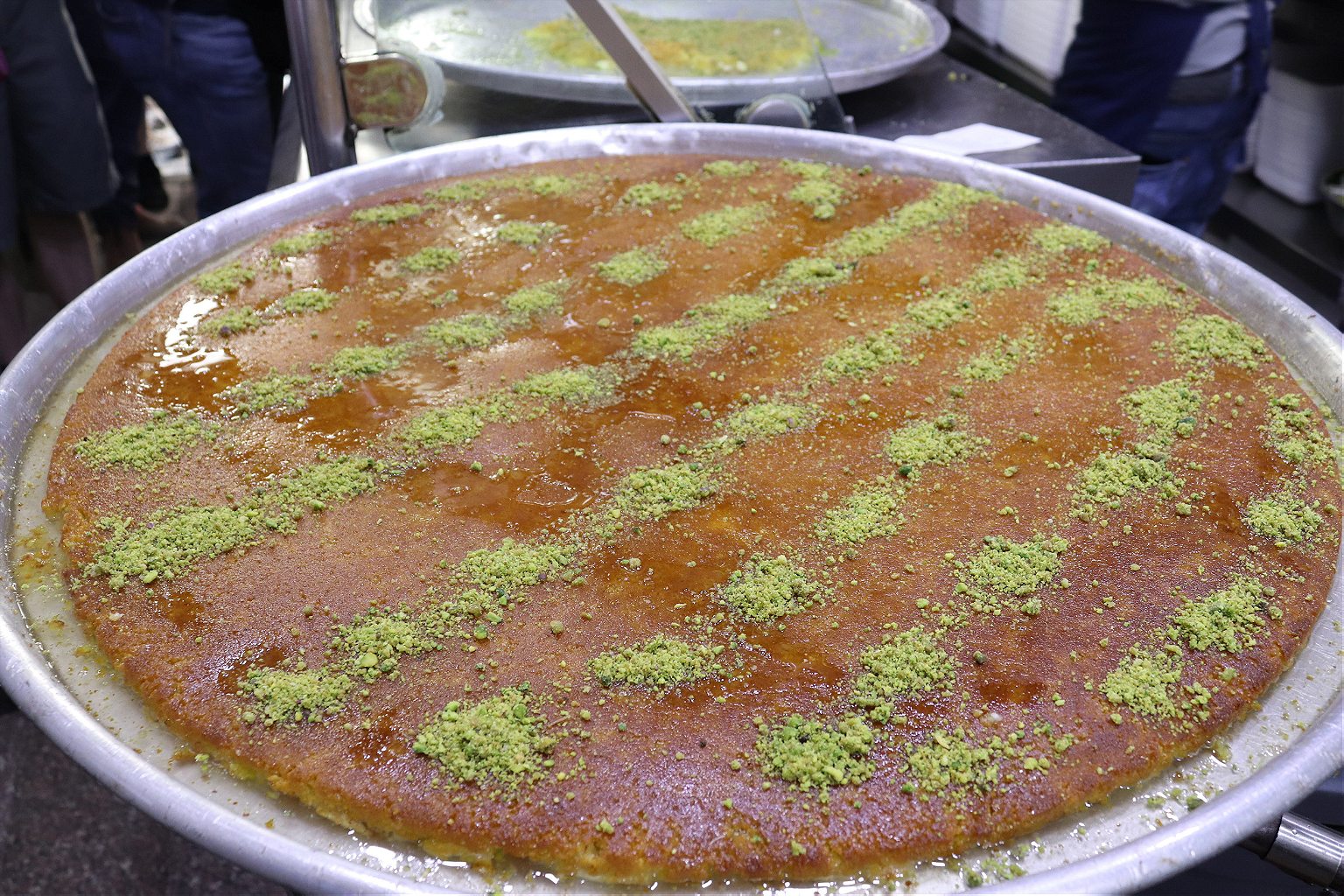

You can’t talk about Jordan without talking about Palestine, and it seems you can’t taste the best Jordanian dishes in Amman without going to shops owned by Palestinians. Millions of Palestinians fled to Jordan in 1948 and 1967, displaced from their homes in modern-day Israel or seeking life without the ongoing military occupation in the West Bank. Some went to refugee camps, which have since turned into poor neighborhoods, while others built up Amman, bringing business skills and diaspora connections crucial to the capital’s development. Around the corner and down the street from al-Quds, which is aptly named after Jerusalem, you’ll find a line of customers waiting for a serving of knafeh at Habibeh.
The store is little more than a kitchen and serving stall, squeezed into a side alley, but deserves its reputation as the best dessert spot in Amman. They serve just two types of knafeh, a Palestinian cheese pastry from Nablus that comes in large round trays the size of a table, where a thick layer of gooey white cheese is covered with crackly, sugared crust, then soaked in sweet syrup with a hint of rosewater and sprinkled with handfuls of crushed pistachios. You can get knafeh khishneh (hard) or na’ama (soft) at Habibeh, choosing between a crunchier crust made from thin noodle threads or a gentle layer of fine semolina dough. Both are divine. 62-year-old Ahmad, the Palestinian-Jordanian from Jenin who manages this branch of Habibeh, says they haven’t changed the recipe since Habibeh was founded in 1951.
Kahi w Gaymar at Sumer in Duwar al-Waha during the day; Masgouf at Al Mahar in Wasfi al-Tal at night
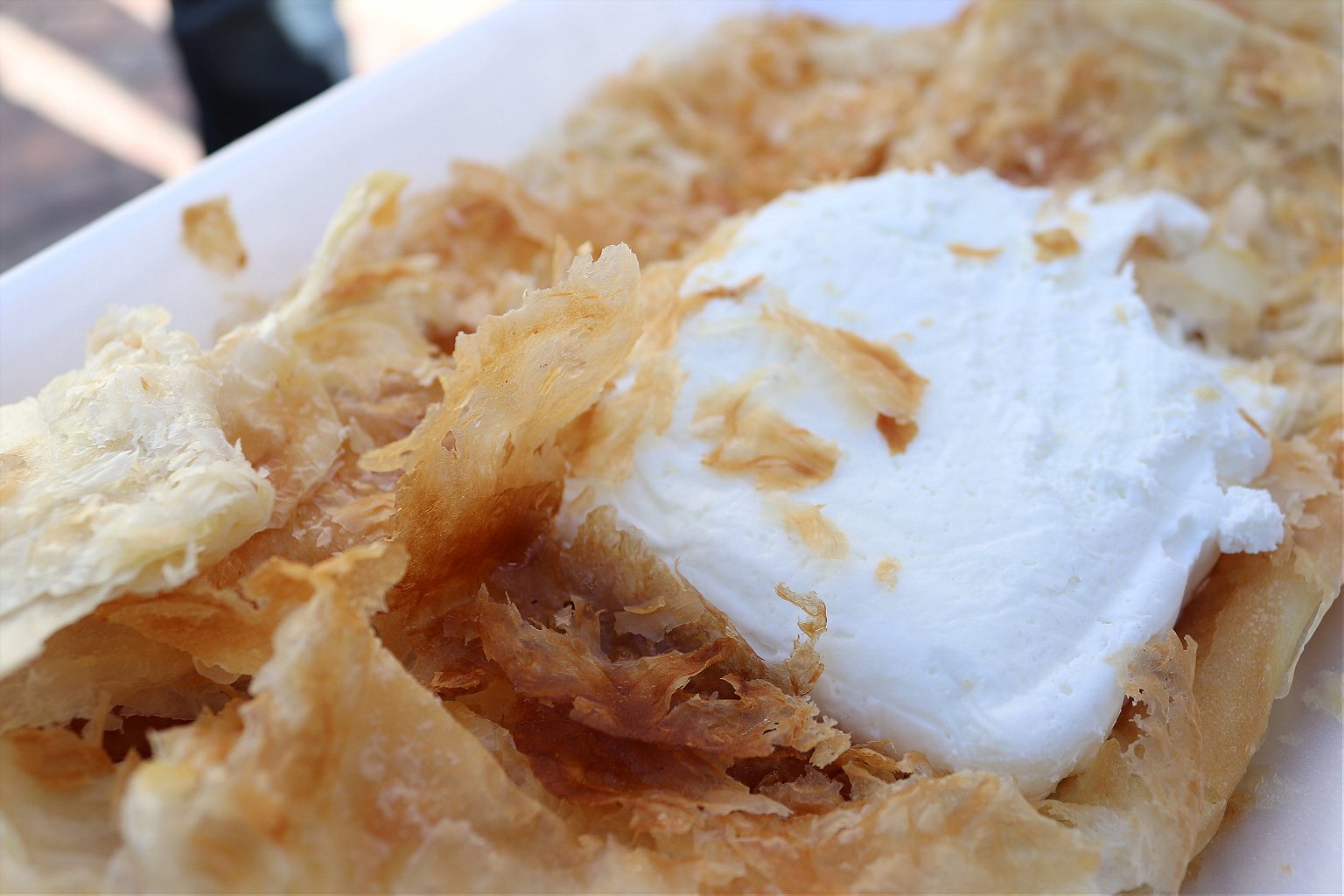
At 8 a.m. on a Friday morning, the Sumer bakery at Waha circle has already had its ovens on for hours, churning out mounds of chewy, diamond-shaped Iraqi samoun bread and round, bubbly Levantine tannour bread baked on the inside of a hot clay oven. The traffic circle sits at the intersection of al-Madina al-Munawarra street and Wasfi al-Tal Street, also known as “Gardenz” street, a busy road paradoxically devoid of gardens but abundant with Iraqi food. Hundreds of thousands of Iraqis came to Amman in two distinct waves: first in the 1990s, following the Gulf War, and again in the early 2000s, following U.S. invasion of Iraq. Many of the Iraqis who came to Jordan were businessmen and former government officials, bringing wealthy families and capacity for investment into Amman—and their tastes for Iraqi food at the same time. At Sumer bakery, the prized pastry for Friday mornings is kahi, a flaky, layered bread in between a croissant and a mille-feuille, topped with gaymar, a thick, rich water buffalo cream that the bakery imports in bulk from Erbil, northern Iraq, each week. The bread is toasted, cream slathered on top and both soaked in sweet syrup, then torn apart and scooped up with your hands.
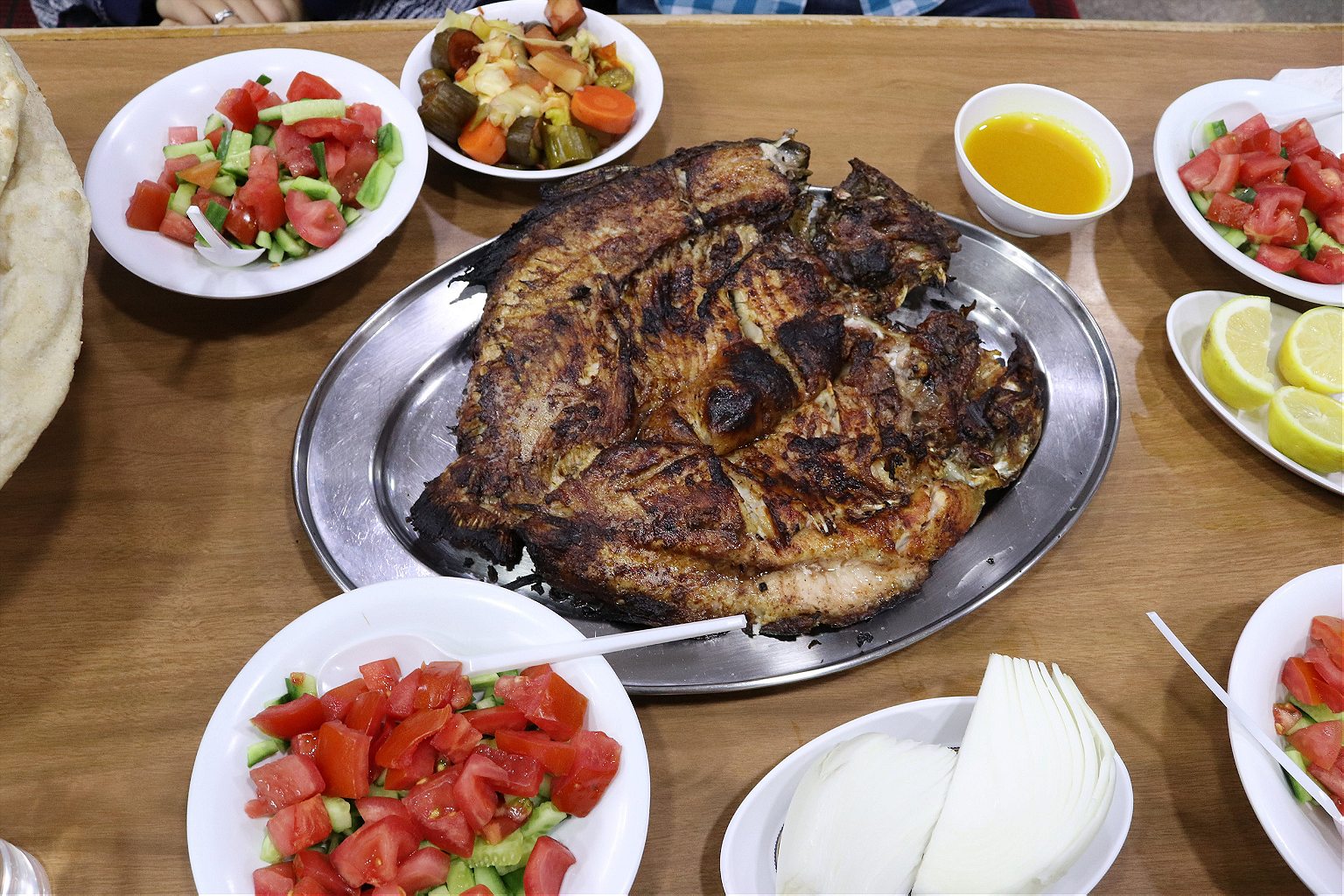
At night, the Iraqi place to go is al-Mahar restaurant on Gardenz street for masgouf. They keep Iraqi carp alive there, fresh and swimming in a big basin until you order it by the kilogram, then killed, cleaned, split in half, basted with olive oil, salt, tamarind, and ground turmeric, smashed between two iron grills and cooked in an open stone oven, wood flames licking at the fish until it’s crispy on the outside, tender and flaky within. It’s served with freshly baked tannour bread, salad, pickles, and a piquant mango chutney that the Iraqis copied from the Indians. Abu Haytham, the 73-year-old restaurant owner who fled to Jordan in 2004, is a Chaldean Catholic who grew up in Mosul but had a masgouf restaurant by the same name in Baghdad. Masgouf quickly grew popular among Jordanians as well, and now Abu Haytham sources his carp from a fish farm in the Jordan Valley.
Chicken biryani at Mohammad Malik Restaurant in Shabsough Street

When the first wave of Iraqi refugees fled to Jordan, they came with an accompanying wave of South Asian migrant workers—Pakistani, Bangladeshi, and Sri Lankan laborers who had cooked, cleaned, and performed other low-income jobs in Kuwait and Iraq. At Mohammad Malik restaurant, a Pakistani cafeteria tucked into a hidden alley near Shabsough street, Malik Mohammad Arif has been cooking samosas, biryani, and other South Asian dishes since he first left Pakistan in 1984. Arif initially worked as a cook for the Jordanian armed forces, and then made Pakistani and Jordanian food for the Jordanian intelligence (“They like biryani,” he says). Eventually, he opened his own restaurant, where you can get generous portions of hot daal, spiced saffron rice, handmade paratha stuffed with potatoes and red, fiery chicken curry, all for just a few JDs. You won’t find the flavors here anywhere else in Amman, and you can also buy the spices and herbs yourself at the Bangladeshi and Sri Lankan markets nearby, in the basement of a building near the gold market on Shabsough street.
Halawat al-jibn at Saloura al-Shahba in Shabsough Street

Go up Shabsough street from the Pakistani restaurant, past the servees stop for taxis to Abdali, and you’ll find Salousa al-Shahba, a Syrian confectionary from Aleppo that has been enticing Ammanis with its halawat al-jibn since 1987. Ahmad al-Samman, the 21-year-old from Damascus who’s behind the counter today, serves the shop’s signature pastry, an indulgent roll of thick cream wrapped in a lighter skin of sweet cheese and semolina, doused with sugar water and covered with fresh crushed pistachios. It tastes like a roll of sweetened snow, reminiscent of ricotta but elevated with the contrast of three different textures at once.
“No one can compete with Syrians in making sweets,” al-Samman says. Since the Syrian crisis began in 2011, hundreds of thousands of Syrian refugees have flooded into Jordan, some of them bringing treats like ice cream from Damascus and kabab from Aleppo. But Jordanians have sought out Syrian sweets like halawt al-jibn since long before the current crisis, al-Samman notes. Within half an hour in the shop, I see three Jordanian couples, a policeman, two Syrians and a Palestinian neighbor pop in and out. Every single one of them ordered halawat al-jibn.
Mandi and salteh at Bab al-Yemen across University of Jordan
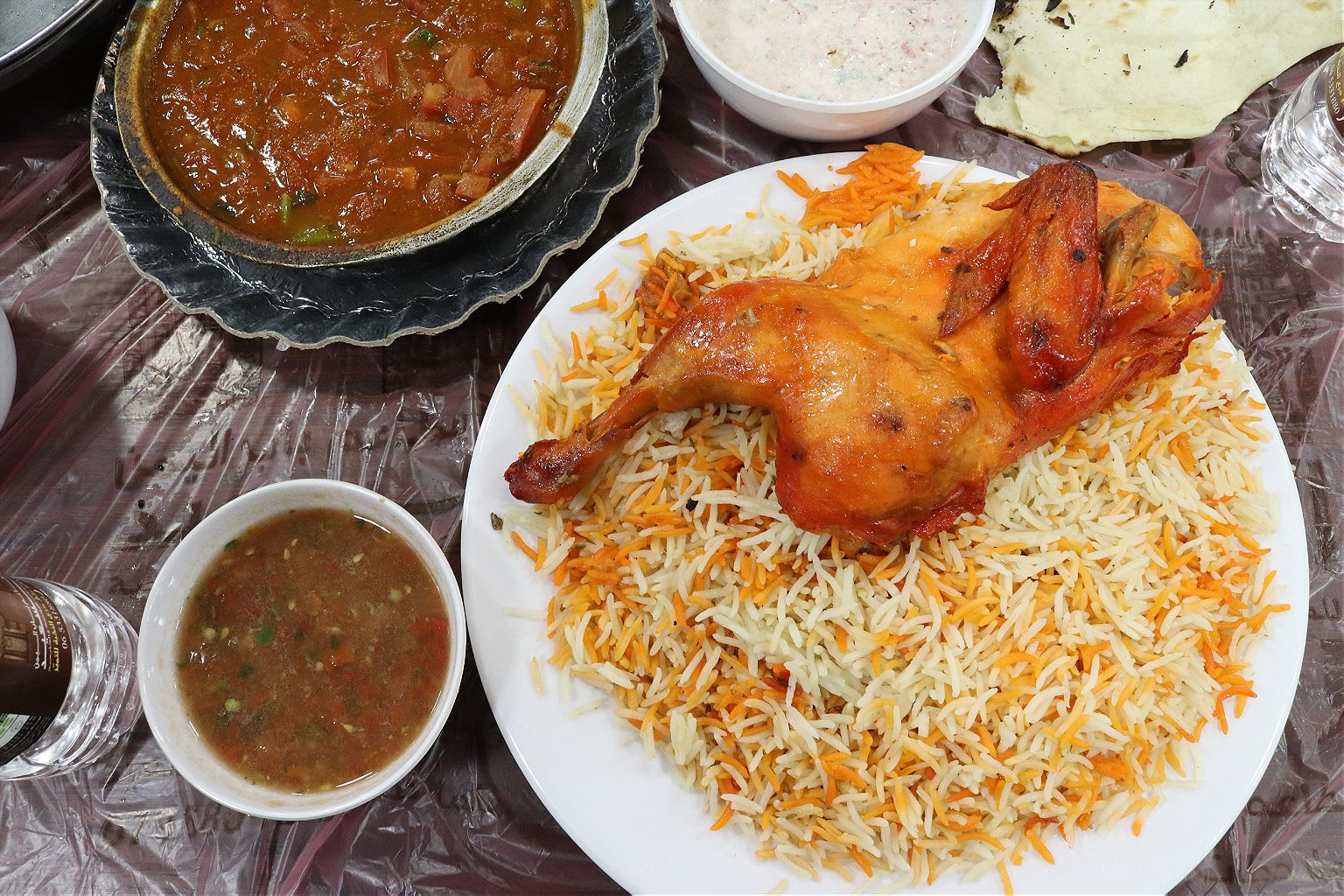

Across the street from the University of Jordan, in northwest Amman, you’ll find two restaurants that share one kitchen: Bab al-Yemen and Sanaa, two branches of a Yemeni restaurant that serve rice-based dishes on one side and bread-based ones on the other, though you can order the same items from both. Walid Ali Hbeisheh, the 29-year old manager of Bab al-Yemen, says his father founded the restaurant in 2001. Yemeni food wasn’t yet very well-known in Amman then, he says, but a growing group of Yemenis were coming to study at the University of Jordan, and they craved the immense, fluffy, addictive Yemeni breads they’d eaten at home.
Walid’s father started serving bread with salteh, a comforting stew of meat or tuna cooked with frothy fenugreek, vegetables, and a salsa rich with chilies, tomatoes, and garlic. Jordanians soon began going out of their way to get Yemeni food, especially mandi, a meat or chicken-and-rice dish that’s distinguished by its cooking method: slow-roasted underground in a clay oven on an enclosed charcoal fire. The rice, already spiced with cardamom, cloves, and peppercorn, becomes perfumed with the chicken drippings and smoke. You eat it with extra sahawiq, a bright tomato-based salsa that includes hot peppers, onions, and sometimes goat cheese.
More Yemenis have come to Jordan in recent years, seeking medical treatment and refuge from one of the worst humanitarian crises in the world. Hbeisheh still has relatives in Aden and Taiz, and are struggling to survive amid ongoing war. All his chefs and employees are also Yemeni, most with relatives stuck facing daily bombardment by Saudi Arabia. Yet they don’t distinguish between Saudi, Jordanian, Yemeni or other customers who come to eat. “Gulf people think Yemenis are less than others. But this is a restaurant. We welcome anyone who wants to come in,” he says.
Ka’ak at Salah al-Din bakery in Abdali

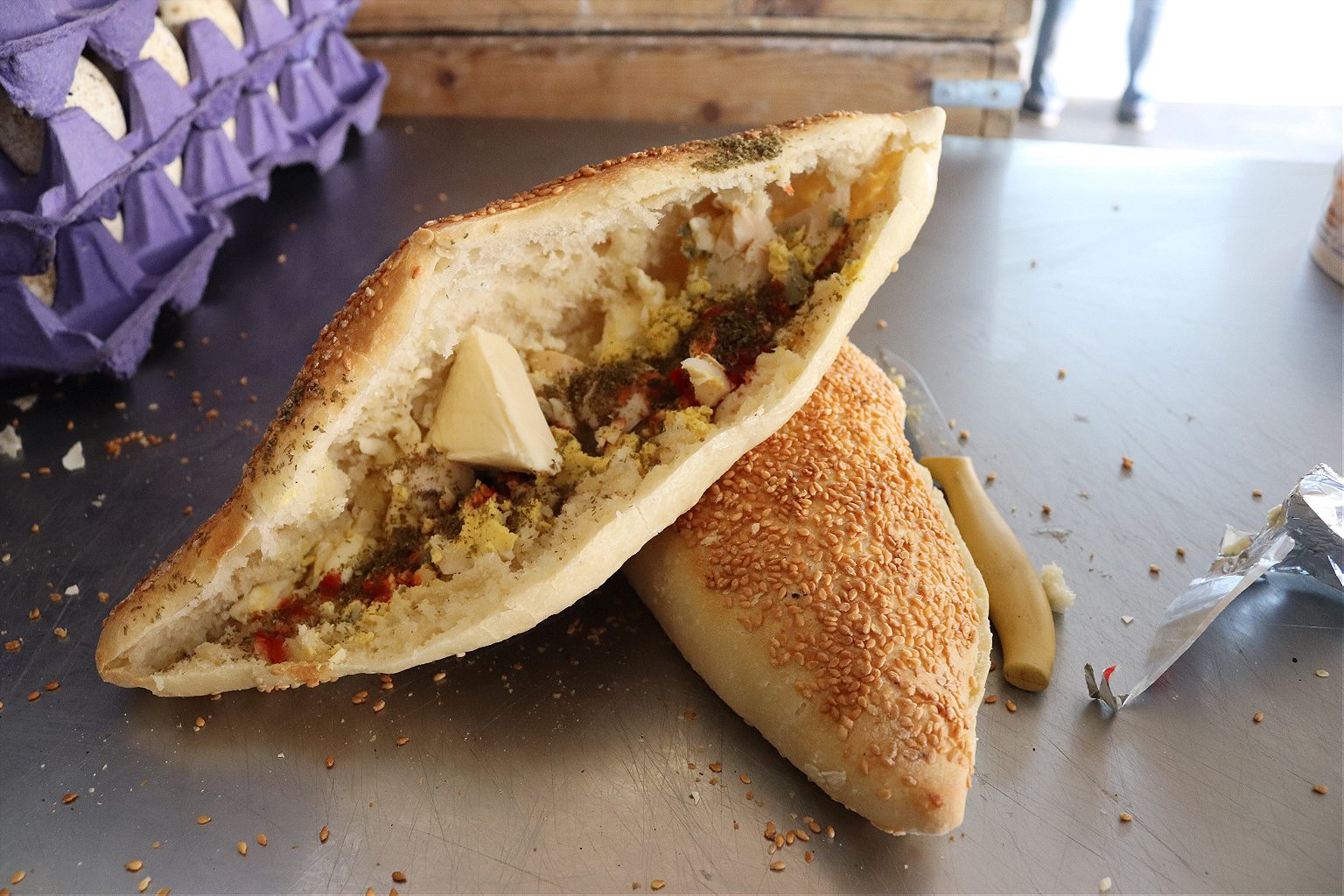
Between Jabal al-Hussein and Jabal al-Weibdeh lies al-Abdali, once a regional transport hub where you could catch daily buses and taxis across easy, open borders to Beirut, Damascus, Baghdad and Medina for pithy prices. On your way, you might stop by Salah al-Din bakery for the city’s best-known ka’ak, a humble sesame sandwich that’s sustained its popularity even as borders close, bus lines shut down and wars tear across the region. Part of the shop’s appeal comes from its DIY approach: you walk in, pick up a fresh, hot piece of sesame bread, then line up at a counter to fill it with hard-boiled eggs, cheese, chili sauce, and za’atar.
The eggs at Salah al-Din are baked for four hours in crates of wood chips to seal in flavor and keep them hot, says 43-year-old Hussein Darraj, whose father, a Palestinian refugee, opened this bakery in 1964. They bake their ka’ak on wood fires, “so you can taste the olives in the sesame bread,” Darraj says.